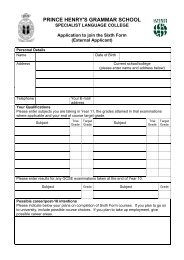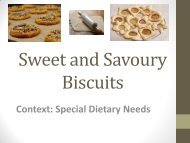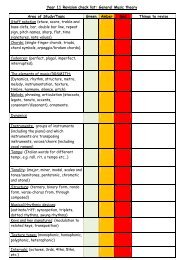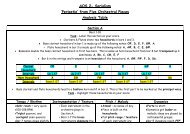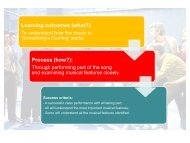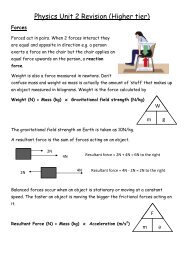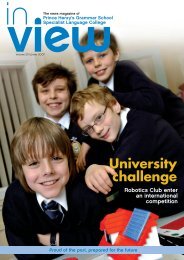2012 GCSE Food Technology Revision
2012 GCSE Food Technology Revision
2012 GCSE Food Technology Revision
You also want an ePaper? Increase the reach of your titles
YUMPU automatically turns print PDFs into web optimized ePapers that Google loves.
Name the followingtemperatures• Fridge 5c• Freezer -18c• Danger zone 5-63c• Boiling water 100c• Safe reheating/cookingtemperature 72c for 2 mins or 75cat core
You must have a goodknowledge of the eat wellplate. It is very useful tohelp with nutrients
•Carbohydrate for energyBrushing your teeth isboring! Create nutrientcards and put them aroundyour bathroom mirror tohelp you revise whilebrushing your teeth tokeep your amused!Nutrient:Source:Function:•Fat for energy, warmth, protection•Vitamin A for healthy eyesight, mucusmembranes, healthy skinissue, night vision•Vitamin B for release energy, formation ofred blood cells•Vitamin C for general good health, ironabsorption, healthy skin,gums, builds immune system and fightsinfection•Vitamin D for calcium absorption andgrowth and maintenance ofstrong bones•Iron for healthy blood and transfer ofoxygen around body•Calcium for healthy bones and teeth,healthy muscles and nerves
The Eatwell PlateThe British Nutrition Foundation has produced six free podcasts on theEatwell Plate. Download the podcast through:YouTube: http://www.youtube.com/britishnutritionYahoo!: http://uk.video.yahoo.com/video/play?vid=1957063&fr=yfp-t-501VideoJug: http://www.videojug.com/film/the-eatwell-plateiTunes: https://fflvideo.solidcasts.com/images/iTunes_btn.png
The Eatwell PlateThe Eatwell Plate is based on the Government’sEight Tips for Eating Well:1. Base your meals on starchy foods2. Eat lots of fruit and veg3. Eat more fish4. Cut down on saturated fat and sugar5. Try to eat less salt – no more than 6g a day6. Get active and try to be a healthy weight7. Drink plenty of water8. Don’t skip breakfast
Design and Make TaskYou have 10 minutes in pairs to design two dishes that fit the following brief:• A biscuit product• A filling or enrobed• Decorative finish• Appeals to people with special dietsMark out of 5 Mark out of 5
How to make BiscuitsMELTING METHOD - PRACTICAL 2Flapjacks200g Rolled oats150g Margarine100g Brown sugar2tbsp Golden syrupVanilla essenceMethodMelt the syrup, fat and sugar over alow heat. Do not boil.Remove from the heat and stir in the oats,making sure they are well coated.Press into a greased baking tin and level out.Bake at 180°C for 15-20 mins until goldenbrown.Mark into fingers and leave for 5 mins, beforeremoving from the tin.
Critical and Quality ControlList 5 quality control points for making biscuitsList 5 critical control points for making biscuits1.1.2.2.3.3.4.4.5.5.
We know that the secondsection can be on theanything.I have broken the nextsection down into sections tohelp you revise.•Research Methods•Data Analysis•Sensory Analysis•Healthy Eating•Temperatures•Developments•Nutritional information•Production (specifications)•Control Checks•Problems in production•Standard components•Environmental Issues•CAM/CAD•Additives
Think about how can Ichange the design to besuitable for people withspecial diets?VeganPeople who eat no animalproducts including meat,dairy (from animals milk)eggs and fish. Manyvegans avoid wearinganimal products also.Lactose IntoleranceVegetarian / vegetarianism.People who chose for a moral,religious or health reason toexclude meat from their diets.(this can include fish, shellfish,animal meats and poultry) .GlutenCoeliac diseaseIs an intolerance to theprotein gluten, which isfound in wheat, barleyand rye. <strong>Food</strong> such asbread, biscuits, cakes andpasta must be avoided.Is an allergy towards milkit can cause suffers tosuffer from allergicreactions and in somecases this can causeconvulsions.Peanut allergyThis often effects small children and asa health warning children under 3 yearsdue to the effects the allergy can cause.Is found in grass related grains,wheat, maize, rice ,rye andbarley. People who have anallergy towards gluten shouldavoid these foods and or eatalternatives.
Specific dietary groupsYou will need to revise specific dietary groups such as:• Diabetics• Coeliacs (require gluten free diet)• Low fat / Low salt – to reduce the risk of coronary heart disease (CHD) / stroke /high blood pressure / obesity• Vegetarian - eat only dairy animal products (milk, eggs, cream etc.)• Vegan – no animal products whatsoever• Nut Allergy• Lactose Intolerant (unable to have cow’s milk / milk products)• Calorie controlled• Specific Religions e.g. Hindus eat no beef, Muslims eat no pork, Jews eat no porkor shellfish
Standard Components• Standard components are pre-prepared ingredients used during the manufacture of foodproducts. They are made at a different time, and often at a different place by anothercompany. Common examples are:• Pre-shaped pastry (e.g. flan case /tart case for savoury flan / tartlet / mini pasty / mini roll)• Readymade pasta• Ready mixes of ingredients (e.g. Cheese sauce, pasta sauce, pastry mixes, curry paste)• Breadcrumbs – for breaded mushrooms / prawns/ chicken goujons• Toppings• Pre-prepared fruit & vegetables (for salads – e.g. Prawn coleslaw, pasta prawn salad, quichefillings, sandwiches, readymade dips)• Grated Cheese• Batter mixes (e.g. For butterflied prawns, Yorkshire puddings)• Readymade sponge flan cases / icings/ cake decorations e.g. Chocolate curlsAdvantages of standard components:Using standard components helps ensure a consistent final product because they are of a standardquality. For example:• standard weight• standard size (e.g. Tart case, pizza finger, bread roll)• standard shape (e.g. pastry case) standard intensity of flavour (e.g. stock cube)• and accurate in ratio (proportions) of ingredients (e.g. sauce mix / pastry/ sponge mix)• Standard components are often used to save time and money. They also help quality control byguaranteeing a consistent and reliable quality. A specialist supplier can often make themcheaply because they can be manufactured in very large numbers on a dedicated production line.
Advantages & Disadvantages of Standard Components• Exam Question:• Why might manufacturers choose to usestandard components?
Hazards in food preparationWhat are Hazards?• Hazards are anything that can cause harm to the consumer. They can occur at any stage in the food productionchain from the field to factory to shop to table.• Biological:• e.g. salmonella in raw chicken , seafood or eggs, Campylobacter (gastroenteritis) found in seafood, meat,poultry & milk; Listeria in soft cheeses and pates, E-coli in cooked meats, Clostridium botulium found incanned fish, meat & vegetables.• Chemical:• e.g. cleaning chemicals, agricultural chemical, paint, oil• Physical: e.g.• Glass from bottles, jars, light fixtures• Metal from machinery, equipment, packaging, jewellery• Wood from pallets, boxes• Insects from plants, open windows• Personal items e.g. jewellery, hair, fingernails, cigarettes• Packaging faults e.g. bags not sealedWhat is ‘<strong>Food</strong> contamination’? <strong>Food</strong> contamination means:• That food has micro-organisms/bacteria in it• <strong>Food</strong> may cause food poisoning / unsafe food• <strong>Food</strong> becomes harmful because of physical/chemical/biologicalcontaminants• You can also refer to ‘high risk foods’ and ‘cross contamination’.You will need to explain how food contamination can be prevented . Include checks on:Staff (clean uniform / healthy / no visible cuts / boils etc.), sanitising & cleaning equipment / surfaces; checkingequipment is safe and in good condition, use of colour coded chopping boards, checking storage temperatures,rotation of stock (FIFO), using reputable suppliers & quality ingredients etc.
Exam QuestionProblem QC/CCP Issue What went wrong? SolutionA hair has beenfound in abiscuitPieces of metalwere found in acakeA pasta dishcontainsbacteriaA white sauce istoo runnyWhen reheatedin themicrowave alasagne is stillfrozen in themiddle
The Danger Zone!• Important temperaturezones:• 0 – 5 o C – fridge temp.• 5 o C – 63 o C – Danger Zone• 72 o C – Temp at which foodmust reach for at least 2minutes to kill bacteria.• -18 o C Freezer temp (+ or –3 o C)
Remember the keytemperaturesDanger ZoneFridgeFreezer
HeadacheHigh Risk foods can leadto food poisoning . Thefollowing are symptomsof food poisoning.DizzinessVomitingStomach crampsDiarrhoea
What is a high risk food?A food which is anideal medium for thegrowth of bacteria ormicroorganisms. Welike moisture, proteinand warmth to grow
What is a controlCheck?You will be asked to relate to control checks inboth sections of the exam. A control check is astep taken to ensure a product is consistentand of the same quality. Safety checks are alsoto ensure consistency
Electrical Kitchen EquipmentHealth and safety rules to be followed by food workers using electricalequipment.• Keep away from water• Follow manufacturers instructions• Check condition of flexes• Check wiring on plug• Do not use with wet hands• Do not leave flexes across water suppliesHandBlender• Check equipment has passed safety checks e.g. PAT tests• Accept equipment specific responses, e.g. blender, mixers• Hold securely / securely based during use.• Keep fingers / clothing/ hair away from any moving parts• Have training in correct use of equipment• Equipment should be clean before/after use• Personal safety precautions/ Wear clean, protective clothing• Concentration during use/ do not leave unsupervised.Tabletop <strong>Food</strong> MixerElectric Whisk
Kitchen EquipmentHow do manufacturers make sure that their employees are safe when using electrical equipment?(4 marks)
Sensory Analysis – What is it?What do I need to know?The senses are key to a good analysis of a food product.Sensory testing is carried out to analyse food products. You wouldhave done sensory testing in your controlled assessment to help youevaluate your work. You must be able to explain how these tests can be carried out.
Ranking Tests•These type of tests are used to test similar products in terms of specific flavour, e.g.sweetness•Each sample should be coded and not put in a rank order. There should be aminimum of ten untrained tasters.•Testers would need to put the products in order of sweetness•Results could be recorded on a tableProfiling testThis is a star diagram – remember your coursework! It is normal to use a 6 point stardiagram. This can be based on descriptive words, e.g. bland, fruity, crunchy.soft10 salty 5fruity0colourfulRating testingThese tests are used to assess a specific flavour or texture. Must be tested by atrained tester. This could involve a seven point scale1. Dislike extremely2. Dislike a lot3. Dislike a little4. Average5. Like a little6. Like a lot7. Like extremelyclear
Sensory Testing<strong>Food</strong> manufacturers use sensory testing when they are creating or improving food products.Testing is always carried out in controlled conditions. This refers to having all conditions thesame, so it is unbiased /has no way of influencing tester / neutral conditions. Examples are:• So useful comparisons can be made between samples• Same size samples• Identical dishes• Identical quantities of food• Coded samples• Same light conditions• Noise free area• Smell free area• Individual booths for privacy• Blind testing/blindfolded• Clarity of instructions given to taste• Water/cracker to refresh mouth after each tasting• Similar charts used to record outcomes
Sensory TestingHow do food manufacturers ensure a fair test? (4 marks)A bakewell tart test gives the following results, howwould you improve this product? (4 marks)
<strong>Food</strong> Additives• They can preserve food for longer so it is easier to transport and sell productsTypes of food additives:• Preservatives• Colourings e.g. tartrazine• E numbers• Flavourings• Emulsifiers e.g. Lecithin (found in egg yolk)• Natural• Raising agents / baking powder• Synthetic• Stabilisers• Anti oxidants• Anti caking agents• humectants• Nutrient and flavour enhancersimprove flavour, texture and appearance• Sweeteners are better for the teeth and have less calories• Some antioxidants like vitamin C are good for your health• They can maintain or improve nutritional values• They increased the variety and quantity of food• Meets dietary needs (e.g. diabetics and sweeteners)• They can preserve food for longer so it is easier to transport and sell products• They improve flavour, texture and appearance• Sweeteners are better for the teeth and have less calories• Some antioxidants like vitamin C are good for your health• They can maintain or improve nutritional values• They increased the variety and quantity of food• Meets dietary needs (e.g. diabetics and sweeteners)• They can preserve food for longer so it is easier to transport and sell products• They improve flavour, texture and appearance• Sweeteners are better for the teeth and have less calories• Some antioxidants like vitamin C are good for your healthAdvantages and disadvantages of food additives:Advantages• Natural additives – no ‘chemical’ content• Enable food to be preserved• Improved colour / flavour• Improve sensory attributes of food• Use out of season• Longer shelf life• Prevent separation of e.g. dressings• Allow colour of product to be constant, e.g. jam• Prevents oxidation of fats in baked productsDisadvantages• Synthetic additives are created in a laboratory• Safety of some additives a concern• Make some foods look unnatural and artificial• Additives need approval from the EU, e.g. some areremoved /withdrawn• Risk of hyper activity in childrenMay give examples e.g. colourings in squash• Other health problems linked to the use of additives:Increased asthmaEczema<strong>Food</strong> intolerances• Unknown health risks of some additives
<strong>Food</strong> AdditivesManufacturers are trying to cut down on using additives infood products due to consumer pressure. Why would theyneed to do this? (5 marks)
Additives<strong>Food</strong> additives can be classified as natural or artificial.Natural additives occur naturally in foods. They are extracted and put into otherfoods. Caramelised sugar is used as colouring in cola.Artificial additives do not occur naturally. They are made synthetically for a certainpurposes. For example tartrazine is a synthetic colouring added to some sweets tomake them yellow.Uses for additivesBoth natural and artificial additives are used for many different reasons:Preservatives extend the shelf life of a product. Salt is used used in bacon andsausages.Colouring makes food products look more appealing and appetising.Flavourings can be used to add or improve the flavour of a food product. Vanillaflavouring is often added to cakes and biscuits.Emulsifiers are used to prevent ingredients from separating. For example, lecithin,which is found in eggs, is used to stop the ingredients in mayonnaise fromseparating.What are Additives?
Quality control checks usingcomputersTypes of control checks:• Timing• Temperatures of oven• Metal detection• Weigh of ingredients• Quality Control, e.g. shape, size• Portion control• Microbiological checks• Other relevant checksWhy Computers are used:• More accurate than humans inminute measurements• Less staff needed / cost reductionin long term• Humans may be unable to carryout the check• Safety• Speed / quicker / saves time/reliability• Ability to record results / store results• Automatic, 24 hours a day• Other relevant reasons
Advantages and disadvantages of usingcomputers to carry out market research.Advantages:• Less human error / more reliable / quicker• Cheaper than employing extra staff toresearch / in long term• Greater accuracy and up to date information• Wider range of information available• More consistent• Easier to carry out analysis of statistics /results• Can be carried out when human not present,24/7• Clearly presented results e.g. graphs, charts• Can make changes easily to update currentdata• Results can be analysed quickly, e.g. on Excel• Easier to import other programs andsoftware.Disadvantages:• May be expensive to set up initially / decreasingprofits• Need to decide on validity of entries on websitesor other information used otherwise results areworthless• Need to train staff in it use or inaccuracies willresult• If information is inaccurate it can affect successof future products based on research• Lack of human interaction may lead to incorrectresults• Lack of compatibility between softwareprograms• Difficulties/costly if system breaks down, needback up.
What are the advantages and disadvantagesof using computers in food production? (6marks)
<strong>Food</strong> LabellingCompulsory:By law, all food manufacturers(people who make foodproducts) must have thefollowing on their food labels:• Name of product• Description of product• Manufacturer’s name & address• Weight or volume• Storage instructions• Cooking or preparationinstructions (e.g. heating upready meals)• List of ingredients (heaviestfirst)• ‘Best before’ / ‘Use by’ date• Optional <strong>Food</strong> Labelling:• <strong>Food</strong> Manufacturers will often add one ormore from the list below, although theseare not required by law:• Illustration (picture / photo)• Bar code or smart code – they identify theprice and are used by shops andmanufacturers for stock control.• Special claim (e.g. ‘low fat’)• Symbol for average quantity (e)• Nutritional information of the product. Ifthe special claim is about a nutrient, thisinformation MUST be included.• Customer guarantee• Price – although lots don’t as they havesmart codes.• Allergy advice• Recycling logos and anti-litter symbols toencourage consumers to recycle.• Serving suggestions e.g. serve withcustard or cream.
What needsto be on thepackaging?The product NameList of ingredientsWeight or volumeStorage instructions Use by date/best before dateManufacturerPlace of OriginAllergic information
The purpose of packaging• Protection - Packaging protects foods from:• Physical damage during transportation and storage• The effects of temperature changes, insect or rodent attacks, mould growth etc.Packaging guarantees food safety and hygiene.• Containing – Packaging contains the contents:• so that they can be transported, stored and displayed easily.• Packaging can make awkwardly shaped products easy to handle.• Preserving –• Packaging can be part of the preservation process such as tin cans and modifiedatmosphere packaging (MAP) (see below).• Identification –• Packaging describes and identifies the contents.• Good packaging design gives a brand image and links other products in the range.• Orange, yellow and blue are popular packaging colours.• Preventing Tampering –• Packaging helps stop the tampering of goods. It’s almost impossible to makepackaging tamperproof, but it can be designed so that it’s obvious if the packagehas been opened.
What packaging materials would be suitable in thefollowing circumstance's? (12 marks)MaterialsReasons for choiceA frozen pizza 12Soup 12Cream cake 12Lasagne 12
Sustainability & Environmental IssuesPackaging Issues:• Excess use leads to poor environmental control /deforestation /world’s natural resources (e.g. oils)running out• Use of recyclable packaging/biodegradable/concernover length of time to decompose• Ethical/ environmental /moral concerns/issues.• no use of packaging if preferable but need to packagecertain foods and for cooking• Land fill• Storage problems for foods and left over packaging• Queries over information provided on packages e.g.Nutritional labelling• Chemicals used in some food packaging• Impact/harm of wildlife• New technologies – vacuum packagingnanotechnology/ coatings, MAP, aseptic (e.g. TetraPak)– benefits and advantages.Seasonality:By purchasing local foods in-season, you eliminate the environmentaldamage caused by shipping foods thousands of miles, your food poundgoes directly to the farmer, and your family will be able to enjoy thehealth benefits of eating fresh, unprocessed fruits and vegetables.<strong>Food</strong>s that are in season are better in terms of nutritive value and arecheaper. Buying seasonal produce also provides an exciting opportunityto try new foods and to experiment with seasonal recipes. It simplytastes better too!See http://www.bbcgoodfood.com/content/local/seasonal/table/<strong>Food</strong> Miles:Is the distance food travels from where its produced to where it’s soldFacts and figures•UK food exports in 1994 - 12 million tonnes. UK food imports in 1994 -20 million tonnes.•Each tonne of food travelled an average of 123 km in 1998 (the averagefigure was 82 km in 1978)Fair Trade:Fair trade foods ensure that the workers orFarmers who produce the foods get a fair price for theirproduce and have a reasonable standard of living. Fairtrade is about guaranteed fair prices for the farmers,farmer workers and their families, better workingconditions and local sustainability. Companies who buythe farmers’ products must pay the market price. Fairtrade foods include coffee, tea, chocolate, icing sugar,caster sugar and bananas.•<strong>Food</strong> in the UK now travels 50% further than it did 15 years ago.•Five large retail chains account for 80% of food sold in the UK.•Transportation of food was responsible for 33% of the increase in roadfreight over the last 15 years.•In the UK, road transport is the only source of a greenhouse gas (carbondioxide) that is still increasing.What can we do about this?Buy locally sourced ingredients and eat in season. Try to avoid buyingingredients that have travelled long distances.
Sustainability & Environmental IssuesExplain the following symbols:
Sustainability & Environmental IssuesExplain why more consumers are choosing to buy their groceries from farmersmarkets. (6 marks)Why are more consumers concerned about the amount of packaging used by foodmanufactures? (6 marks)
Research MethodsList the differentways to find outinformationProduct AnalysisPrior KnowledgeBooksInternetNutritional informationInternetQuestionnaire
Make sure you triple check youranswers when using data theyhave given you. Silly mistakescan be made loosing easy marks.Bread 1960’s 1980’s 2000White Bread 75% 50% 41%Bagel 2% 6% 7%Ciabatta 8% 20% 22%Croissant 3% 9% 11%Naan 9% 11% 14%
Design specificationThis will be a general list of bullet points aboutwhat your design must have. A lot of theinformation will come from your research. Specifypoints such as:• Target group•Diets•Ingredients•Nutritional information e.g. low in salt•Texture•CostYou need to knowwhat a specification isasking for. There aretwo types ofspecification.Product SpecificationThis is a very detailed specification and usesinformation gathered from research and designideas you have tested out. You will eventuallyevaluate your work against the productspecification. A product specification will berelevant to just one product. E.g. Meatballs andpasta.
The exam maygive yousituations foryou to developyour dish. Havea go at the fewbelow?Product – to helpeach product meethealthy guidelinesBeef Pattie withshortcrust pastryCarrot Cake withbutter icingDevelopment 1 Development 2Why?Why?Why?Why?Chocolate mousseWhy?Why?
You need to know howto highlight a faultwhen a product hasnot turned out welland suggest how it canbe prevented. Have ago at the following.Product Fault Reason for Fault How could youprevent this fromhappening?Filo pastry is dryand breaks upwhen handledThe filling leaksout of the parcelduring cookingPieces of shellare found in thefillingThe creamysauce is thin andrunny
What is astandardcomponent?A Standard Component isa pre-prepareditem/ingredient that isused in the production ofanother product.You must be able to• Understand and define the term‘Standard Component’• Understand why standardcomponents are used in foodproduction• To identify the advantaged anddisadvantages of using a standardcomponent.
What do I need toknow about theenvironmentalconsiderations?• Understand how the use ofpackaging has an impact onthe worlds resources• Understand the sourcing offood affects theenvironmental climate.Answer the questions on the nextpage to help you revise. You willneed to know the answers
What arenanofoods?What arefarm assuredfoods?What are<strong>Food</strong> miles?
What areorganicfoods?What are fairtrade foods?
CAD = Computer aidedDesignUsing computer design programsto help with designing a foodproduct for example sensory stardiagrams• Understand thedifference between CADand CAM• Understand how eachcan be used inproductionCAM = Computer aidedManufactureUsing computers to control the processof mass production for example a breadmaker
Good Luck!Don’t Panic and make sureyou write an answer foreach question, even if it is aguess!



